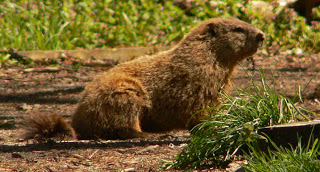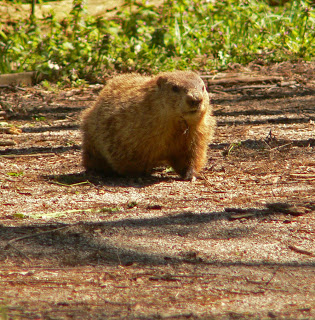February 2 is Groundhog’s Day. Is everyone ready for a big party? No? Well, let’s learn more about the groundhog itself. The groundhog (Marmota monax), also known as a woodchuck, whistle-pig, or in some areas as a land-beaver, is a rodent of the family Sciuridae, belonging to the group of large ground squirrels known as marmots. Although they burrow in the ground, they are able to climb trees.
The average groundhog excavates over 700 pounds of dirt digging just one den, and a single groundhog may have four or or five dens scattered across its territory, moving in and out of them as crops and weather change.The most common locations of permanent groundhog dens are fence lines and thickets bordering hay and corn fields, vegetable farms, and fruit orchards. Here tangles of multiflora rose, kudzu, honeysuckle and small trees provide the kind of cover that enable a groundhog to enter and leave its den, shielded from the rushing attack of farm dogs, coyotes, and fox. Groundhog burrows are important shelter resources for red fox, gray fox, opossum, raccoon, and skunk, most of whom do not dig their own burrows, but simply occupy those of groundhogs. Today, there are more groundhogs, red fox, gray fox, opossum and raccoon in the United States than at any previous time in U.S. history.
Groundhogs are vegetarians, eating leaves, flowers and soft stems of various grasses, and field crops such as clover and alfalfa. Certain garden crops like peas, beans and carrots are favorites. Groundhogs occasionally climb trees to obtain apples and pears — one reason they are disliked by many orchard owners. Groundhogs are capable of consuming as much as three-fourths of a pound of vegetable matter a day — the equivalent of a 175-pound person eating 15 pounds of salad a day. In order to maximize food intake, groundhogs will often dig summer burrows in the middle of pastures or meadows, so that that they do not have to go far to go to get to the “salad bar.”
Groundhogs are considered a major agricultural pest in most areas, and most farmers are anxious to get rid of them or reduce their number. It is very common for a single groundhog to take a bite out of dozens of pumpkins in just a few days, ruining each of them for Halloween sale. The same kind of destruction is visited on bell peppers, squash and zucchini.
Do groundhogs really predict the weather? Groundhog Day (Pennsylvania German: Grundsaudaag, Murmeltiertag) is a day celebrated on February 2. According to folklore, if it is cloudy when a groundhog emerges from its burrow on this day, then spring will come early; if it is sunny, the groundhog will supposedly see its shadow and retreat back into its burrow, and the winter weather will continue for six more weeks. In Pennsylvania, it was a good reason for a party just when everyone was getting really tired of winter. You had to speak the Pennsylvania German dialect, and pay a penalty if you broke into English. Lots of good food and speeches (whether good or not) were the main attraction of the day, plus a trip in the snow to find a groundhog. Groundhogs hibernate during the winter, but wake up in early to mid-February when (you guessed it) it’s time to find a mate and breed. The babies are born about a month later, and stay in the den for another 6 or 7 weeks. Think about it. February 2 is about half way between the winter solstice and the spring equinox, so there will be 6 weeks until a new season no matter which way you add it up!




